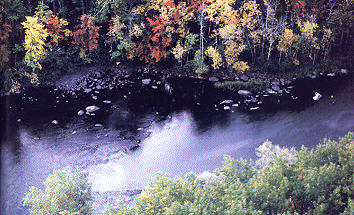To people not familiar with bass or bass fishing, an obvious
question is: "What's the difference between largemouth and smallmouth
fishing? Those fish are just the same except for the size of their mouths,
aren't they?"
Actually, there is a good deal of difference between the two species
and those differences have a great effect on how you fish for them and
how successful your fishing will be.
It is amazing that two fish that are so closely related and look so
much alike can really be so different. The smallmouth bass
(Micropterus dolomieui) is, like its cousing the largemouth,
a member of the sunfish family. It is relatively slender fish and has a fairly
large mouth, but its jaw does not extend past the rear edge of its eye. There
is a shallow notch that separated the spinour portion of the dorsal fin
from the soft rear portion. The smallmouth's back and sides are generally a
greenish-brown color with subdued dark-colored mottling and several vertical
bars. Its belly is usually a dirty shade of white.
Fishermen refer to the smallmouth by many names, like bronzeback,
black bass, brown bass, and even green trout.

While the largemouth is usually found in still-water spots like ponds,
lakes and reservoirs, the smallmouth prefers the clear, clean waters of
moderately fast-flowing streams and rivers, though it does do well in some
still-water impoundments.
Where they occur in ponds, lakes and reservoirs, smallmouths tend
to concentrate near the mouths of rivers flowing into the impoundment,
or in areas of the lake where current is created by the wind. When you
are searching for smallmouths, the best place to start looking is that part
of the lake where the water is the clearest and the cleanest.
In a stream or river, the fish congregate in spots with moderate
current. They like to lie behind downed trees and behind rocks in small
pools where there is a noticeable current, rather than in very slow-moving
pools or those where the water is completely still.
Smallmouths are usually associated with rocks in some form -
gravel, boulders, scattered rock, or riprap. The fish need rock to
spawn successfully and they prefer to spawn directly in the rocks, over
gravel, or bottoms covered with sand. Biologists say smallmouth nests
that are constructed in silty lake or stream bottoms are rarely successful.
Many anglers have misconceptions about smallmouth bass.
Unfortunately, the smallmouth is a fish that prefers to live in cool, clear
flowing waters rather than the warmer water normally found in reserviors,
lakes and ponds. Because they grow rather slowly and because many
excellent smallmouth waters are in the north where the growing season is
shorter than it is in the south, smallmouths just don't get as big as their
largemouth cousins.
Because the smallmouth is not readily available in many parts of the
country and because it is not capable of attaining a real heavyweight status,
it has not enjoyed the immense popularity of the more common largemouth.
On the other hand, the smallmouth can be more difficult to catch and
it fights stubbornly until it either escapes, which is often, or is landed by
the angler. One of its favorite tactics is to jump or roll on the surface trying
to shake the lure from its mouth. If it can't throw the hook, it dives and
heads for deeper water to continue the fight. In my opinion, smallmouths
are the most acrobatic of all freshwater gamefish. That's why I'd rather
catch a 4-pound smallmouth on fly fishing gear than a 6-pound largemouth
on the same equipment - smallmouths are just that much more exciting and
fun to catch. ~ Tom Keith
More on Smallmouth Bass Fishing Next time!
|



